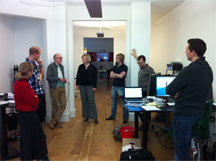
A typical standup meeting. Photo (cc) Klean Denmark courtesy Wikimedia.
Organizational culture is the set of attitudes, values, norms, and beliefs widely held by members of the organization. The elements of culture need not be self-consistent, but they affect the organization's goals, strategies, and structure, and its approaches to setting and achieving its objectives. The people of the organization need not be aware of every cultural element, nor is their behavior always consistent with the culture.
Culture can contribute to troubles in meetings. For example, if harmony is highly valued, people try to please — and avoid displeasing — each other. These tendencies can elevate the chances of taking a Trip to Abilene, which happens when everyone in a group agrees to a proposal that nobody actually wants, because they all believe that everyone else favors it.
Here are three examples of meeting troubles that have cultural causes.
- Insufficient facilities
- Organizations can sometimes be shortsighted about cost control. They invest too little in meeting facilities, especially those for virtual teams, which have expensive requirements. Scarcity of adequate facilities causes teams to claim time slots in advance of known needs. Once they claim a time slot, they feel obliged to meet, and to use the entire slot. This sense of pressure to meet can lead to a waste of everyone's time. If teams cannot secure the facilities they need, they meet in settings unsuited to the task — for example, an audio-only virtual workspace to conduct discussions that actually need an electronic whiteboard. When such mismatches occur, groups tend not to account for the shortcomings of the meeting setting. Meetings run overtime and output quality suffers.
- Reducing facilities Cultures that value teamwork
sometimes confuse working
together with getting togetherexpense is often the most expensive strategy, if we account for the cost of the resulting delays and bad decisions. - Serial submeetings
- Cultures that value teamwork sometimes confuse working together with getting together. Often, a team meets as one, when meeting as subteams would be more effective. One indicator of this pattern is a meeting consisting of serial submeetings — a sequence of discussions in which few people are involved or qualified to contribute. Each subteam takes its turn, while everyone else looks on.
- For increased effectiveness, the team could have the subteams meet in parallel or at times they choose, reporting afterwards to the whole any issues or surprises. This creates free time for the team to assemble to address shared issues, or to connect socially.
- Ritualized standups
- Standup meetings are increasingly popular, especially in organizations that value Agile processes. Standups are supposedly shorter because of the discomfort of standing. But they don't help at all unless the content of the meeting is suited to that form, which works best for quick check-ins, for a total of at most 15 minutes.
- Extended discussion of complex issues still requires chairs, a table, and maybe other equipment — like a notepad or a laptop and projector. Use a standup only when it fits the agenda.
You've probably seen other examples of cultural causes of meeting troubles. Send them along and I'll include them in a future installment of this growing collection. ![]() First issue in this series
First issue in this series ![]() Top
Top ![]() Next Issue
Next Issue
Do you spend your days scurrying from meeting to meeting? Do you ever wonder if all these meetings are really necessary? (They aren't) Or whether there isn't some better way to get this work done? (There is) Read 101 Tips for Effective Meetings to learn how to make meetings much more productive and less stressful — and a lot more rare. Order Now!
Your comments are welcome
Would you like to see your comments posted here? rbrenaXXxGCwVgbgLZDuRner@ChacDjdMAATPdDNJnrSwoCanyon.comSend me your comments by email, or by Web form.About Point Lookout
 Thank you for reading this article. I hope you enjoyed it and
found it useful, and that you'll consider recommending it to a friend.
Thank you for reading this article. I hope you enjoyed it and
found it useful, and that you'll consider recommending it to a friend.
This article in its entirety was written by a human being. No machine intelligence was involved in any way.
Point Lookout is a free weekly email newsletter. Browse the archive of past issues. Subscribe for free.
Support Point Lookout by joining the Friends of Point Lookout, as an individual or as an organization.
Do you face a complex interpersonal situation? Send it in, anonymously if you like, and I'll give you my two cents.
Related articles
More articles on Effective Meetings:
 Mastering Meeting Madness
Mastering Meeting Madness- If you lead an organization, and people are mired in meeting madness, you can end it. Here are a few
tips that can free everyone to finally get some work done.
 Social Distancing for Pandemic Flu
Social Distancing for Pandemic Flu- It's time we all began to take seriously the warning about a possible influenza pandemic. Whether or
not your organization has a plan, you can do much to reduce your own chances of infection, and the chances
of mass infection, by adopting a set of practices known as social distancing.
 Preventing Sidebars
Preventing Sidebars- Sidebar conversations between meeting participants waste time and reduce meeting effectiveness. How
can we prevent them?
 Virtual Brainstorming: I
Virtual Brainstorming: I- When we need to brainstorm, meeting virtually carries a risk that our results might be problematic.
Here's Part I of some steps to take to reduce the risk.
 Chronic Peer Interrupters: I
Chronic Peer Interrupters: I- When making contributions to meeting discussions, we're sometimes interrupted. Often, the interruption
is beneficial and saves time. But some people constantly interrupt their peers or near peers, disrespectfully,
in a pattern that compromises meeting outcomes. How can we deal with chronic peer interrupters?
See also Effective Meetings for more related articles.
Forthcoming issues of Point Lookout
 Coming October 1: On the Risks of Obscuring Ignorance
Coming October 1: On the Risks of Obscuring Ignorance- A common dilemma in knowledge-based organizations: ask for an explanation, or "fake it" until you can somehow figure it out. The choice between admitting your own ignorance or obscuring it can be a difficult one. It has consequences for both the choice-maker and the organization. Available here and by RSS on October 1.
 And on October 8: Responding to Workplace Bullying
And on October 8: Responding to Workplace Bullying- Effective responses to bullying sometimes include "pushback tactics" that can deter perpetrators from further bullying. Because perpetrators use some of these same tactics, some people have difficulty employing them. But the need is real. Pushing back works. Available here and by RSS on October 8.
Coaching services
I offer email and telephone coaching at both corporate and individual rates. Contact Rick for details at rbrenaXXxGCwVgbgLZDuRner@ChacDjdMAATPdDNJnrSwoCanyon.com or (650) 787-6475, or toll-free in the continental US at (866) 378-5470.
Get the ebook!
Past issues of Point Lookout are available in six ebooks:
- Get 2001-2 in Geese Don't Land on Twigs (PDF, )
- Get 2003-4 in Why Dogs Wag (PDF, )
- Get 2005-6 in Loopy Things We Do (PDF, )
- Get 2007-8 in Things We Believe That Maybe Aren't So True (PDF, )
- Get 2009-10 in The Questions Not Asked (PDF, )
- Get all of the first twelve years (2001-2012) in The Collected Issues of Point Lookout (PDF, )
Are you a writer, editor or publisher on deadline? Are you looking for an article that will get people talking and get compliments flying your way? You can have 500-1000 words in your inbox in one hour. License any article from this Web site. More info
Follow Rick
Recommend this issue to a friend
Send an email message to a friend
rbrenaXXxGCwVgbgLZDuRner@ChacDjdMAATPdDNJnrSwoCanyon.comSend a message to Rick
![]() A Tip A Day feed
A Tip A Day feed
![]() Point Lookout weekly feed
Point Lookout weekly feed
 My blog, Technical Debt for Policymakers, offers
resources, insights, and conversations of interest to policymakers who are concerned with managing
technical debt within their organizations. Get the millstone of technical debt off the neck of your
organization!
My blog, Technical Debt for Policymakers, offers
resources, insights, and conversations of interest to policymakers who are concerned with managing
technical debt within their organizations. Get the millstone of technical debt off the neck of your
organization!